2015 Ducati 1299 Panigale First Ride Review + Video
A beastlier beast from the maker of Monsters
The final corner of the Autodromo Internacional Algarve is a wickedly fast downhill sweeper that launches riders onto the track’s front straight at 120-plus mph. Not long after bringing a bike upright is a mild hill that’s taken at full throttle. At its crest, the front wheel of Ducati‘s latest Panigale sensationally begins pointing skyward while traveling upward of 140 mph. The 1299 Panigale is indeed something special, boasting more power than any other widely available motorcycle ever to see a public road.
2015 Ducati 1299 Panigale
| Engine | 20.0/20 |
| Suspension/Handling | 14.0/15 |
| Transmission/Clutch | 9.5/10 |
| Brakes | 10.0/10 |
| Instruments/Controls | 4.5/5 |
| Ergonomics/Comfort | 7.5/10 |
| Appearance/Quality | 9.5/10 |
| Desirability | 9.5/10 |
| Value | 7.0/10 |
| Overall Score | 91.5/100 |
Americans are sometimes derided elsewhere around the globe for our bigger-is-better mentality. It appears that Ducati, the Italian OEM which has just launched this 1285cc superbike, has no issues with that philosophy.
2014 EICMA: 2015 Ducati 1299 Panigale Preview
Ironically, it was Ducati which, at one time, raced an 851cc machine in a class that allowed V-Twins up to 1000cc. But today, the boys from Bologna are proffering an engine too large to fit into the rules for Superbikes.
The concept is similar to Kawasaki‘s 2003-2006 ZX-6R that offered 636cc of displacement. The ZX-6RR provided the basis for meeting 600cc supersport rules, while the 6R was offered to street riders who had no such size restrictions. In Ducati’s case, the existing 1198cc Panigale R continues to be the platform to fit Superbike rules, while the new 1299 gives street and trackday riders more displacement – and more power – to play with.
And it’s a big power play. The newest Panigale boasts a lofty 205-horsepower rating at its crankshaft, but that’s only a fraction of the story. Torque output is where the 1299 dominates any discussion of sportbike power, flaunting a stellar 106.7 lb-ft. at its 8750-rpm peak. Yamaha‘s latest R1 is purported to produce a shining 200 hp, just a few horses shy of the Duc, but its torque rating is a relatively limp 83 lb-ft. The only sporty bike at a comparable torque level is KTM’s Super Duke R that claims 106 lb-ft. of twist.
2013 Ducati 1199 Panigale R Review + Video
To create the 1299’s powerplant, Ducati hogged out the cylinders by an extra 4mm over the already highly oversquare 1199, now up to 116mm. Employing a longer stroke would seem to be a more logical way to get extra cubes, but the 1199’s crankcases wouldn’t allow additional vertical movement.
It’s definitely the extra power from the Superquadro V-Twin that impressed most while lapping the wonderfully challenging circuit near Portimao, Portugal, where Ducati hosted the global launch of the 1299 Panigale. The previous 1199 wasn’t short on power, but it was surprisingly peaky for a 1.2-liter V-Twin.
This latest version supplies the midrange grunt expected from such a motor but is then supersized into a robustly torquey animal unlike any sportbike ever made. Ducati says the 1299 twists out an extra 15% of torque from 5000-8000 rpm, and that claim feels entirely believable after even a short time in the Panigale’s new and marginally more comfortable saddle.
The meatier midrange response results in a wonderfully deep well of power that yanks the big Panigale hard each time the ride-by-wire throttle is opened. Riding a gear high is now a viable option. The plentiful torque is always ready to rotate the 1299 and hoik up its front wheel.
With so much power on tap, it’s reassuring to know that Ducati continues to advance its gamut of electronic rider aids. In addition to the ride modes, traction control and a quickshifter expected on a contemporary sportbike, the 1299 now adds a specific wheelie-control function, Cornering ABS and a clutchless downshift feature to its menu of electronic crutches to lean on.
The electronic brain behind this technology is a new 3-axis Inertial Measurement Unit from Bosch that monitors speed, acceleration, lean angle and longitudinal pitch. The 9.1MP IMU replaces the previous 9ME that was about 2 pounds heavier and didn’t include Cornering ABS functionality. All of the electronic rider aids can be switched off, but the adjustability and seamlessness of the 1299’s e-aids makes disengaging them a foolhardy option.
There are eight levels of Ducati Traction Control, ranging from crossed-up power slides to nearly impossible to crash. Ducati Wheelie Control also has eight levels with a similar amount of control as DTC. My favorite was DWC 3, which still allowed generous wheelies. Another rider had set DWC to level 8 (maximum) before one of my sessions, and the gauges’ DWC intervention lamp blazed pretty much the entire lap!
DWC also helps calm a flightiness when hard on the gas. There is so much power that the front tire is always trying to leave the ground, causing the handlebars to twitch despite a steering damper. It never got into a tank-slapper, but it’s a little less stable than the 1199.
There are so many electronic gadgets onboard that I couldn’t adequately test all of them – riding a 200-pony superbike around the tricky Portimao circuit kept me plenty busy. Cornering ABS, which takes into account lean angle, seemed to work, but I never summoned the courage to jam on the brakes while leaned over. When Race mode is selected, ABS works only on the front wheel and disables the Cornering ABS function.
There are three levels of Engine Brake Control, which subtly lifts the throttle plates to alleviate undesirable amounts of rear-wheel slowing. Level 3 works so well that having a slipper clutch, as the 1299 does, seems to be a needless expense (cost and weight) on future ride-by-wire engines.
The next most noticeable revision to the 1299 after the additional stonk from its motor is a couple of seemingly small tweaks to the Panigale’s chassis specs. A steering head cup borrowed from the 899 Panigale reduces rake by half a degree to 24.0 degrees and condenses the trail number by 4mm to 96mm. And, importantly, the 1299’s swingarm pivot location was lowered by 4mm, which, based on Ducati’s recent racing experience, significantly increases grip at the rear tire.
The 1199 Panigale was already an incredibly nimble machine for a liter-sized sportbike, and the mods to the 1299’s rake/trail numbers deliver even greater agility that is fantastical for a motorcycle with a 1.3-liter engine. Ducati says the 1299 weighs 396 lbs with its 4.5-gallon aluminum tank empty; 420 lbs fully fueled.
These engine and chassis changes add up to a shockingly large performance increase. Ducati’s test rider, Alessandro Valia, told me he lapped Italy’s Mugello circuit a massive 2.5 seconds quicker on the 1299 than he did on the 11.
I had one session aboard a 1299 outfitted with several pieces from the Ducati Performance catalog, including a titanium Akrapovic exhaust which releases even more power. I saw 295 kph (183 mph) on its speedo at the end of Portimao’s front straight, which was higher than indicated on the stock bike. The Akra pipe unleashes copious amounts of Ducati thunder that, relatively speaking, made the stock bike’s exhaust note sound thin. Although it was equipped with a fuel map to suit the pipe, low-rpm fueling was a little rougher.
My time with Ducati’s super-duper-bike makes me wonder how a sporting motorcycle could possibly get much better. Caveats about the 1299 Panigale are few and minor, at least during racetrack use and abuse.
But 2015 is offering up what looks to be the golden era of liter-size sportbikes, with a plethora of all-new or significantly updated models ready to vie for your dollars. Besting the revised 2015 BMW S1000RR will be tough, and then there’s Aprilia’s significantly updated RSV4. Perhaps the greatest challenge will come from Yamaha’s ground-up re-do of its R1, which we’ll get to ride in just a few weeks.
2015 Literbike Spec Chart Comparo
But it’s difficult to imagine a rider being anything less than thrilled by this supremely powerful, exotically sexy and technologically advanced tour de force from Italy. The 1299 Panigale is that good.
+ Highs
- Hand-of-God power
- Middleweight-like agility
- Supermodel good looks
– Sighs
- Difficult-to-access sidestand
- Ain’t cheap
- Doesn’t come with its own race track
| Ducati 1299 Panigale | Ducati 1299 Panigale S | |
|---|---|---|
| Engine Type | Superquadro: L-twin cylinder, 4 valve per cylinder, Desmodromic, liquid cooled | Superquadro: L-twin cylinder, 4 valve per cylinder, Desmodromic, liquid cooled |
| Displacement | 1,285 cc | 1,285 cc |
| Bore x Stroke | 116 x 60.8 mm | 116 x 60.8 mm |
| Compression Ratio | 12.6:1 | 12.6:1 |
| Power | 205 hp (150.8 kW) @ 10,500 rpm | 205 hp (150.8 kW) @ 10,500 rpm |
| Torque | 106.7 lb-ft (144.6 Nm) @ 8,750 rpm | 106.7 lb-ft (144.6 Nm) @ 8,750 rpm |
| Fuel injection | Mitsubishi electronic fuel injection system. Twin injectors per cylinder. Full ride-by-wire elliptical throttle bodies. | Mitsubishi electronic fuel injection system. Twin injectors per cylinder. Full ride-by-wire elliptical throttle bodies. |
| Exhaust | 2-1-2 system with catalytic converter and 2 lambda probes. Twin stainless steel mufflers with alumimum end caps. | 2-1-2 system with catalytic converter and 2 lambda probes. Twin stainless steel mufflers with alumimum end caps. |
| Emissions | Euro 3 | Euro 3 |
| Gearbox | 6 speed with Ducati Quick Shift (DQS) up/down | 6 speed with Ducati Quick Shift (DQS) up/down |
| Ratio | 1=37/15 2=30/16 3=27/18 4=25/20 5=24/22 6=23/24 | 1=37/15 2=30/16 3=27/18 4=25/20 5=24/22 6=23/24 |
| Primary drive | Straight cut gears, Ratio 1.77:1 | Straight cut gears, Ratio 1.77:1 |
| Final drive | Chain 525; Front sprocket 15; Rear sprocket 39 | Chain 525; Front sprocket 15; Rear sprocket 39 |
| Clutch | Slipper and self-servo wet multiplate clutch with hydraulic control | Slipper and self-servo wet multiplate clutch with hydraulic control |
| Frame | Monocoque aluminum | Monocoque aluminum |
| Wheelbase | 1,437 mm (56.57 in) | 1,437 mm (56.57 in) |
| Rake | 24.0° | 24.0° |
| Trail | 96 mm (3.78 in) | 96 mm (3.78 in) |
| Steering lock (total) | 48° | 48° |
| Front suspension | Marzocchi 50 mm pressurized and fully adjustable usd fork with hard anodized aluminum lightweight slider | Öhlins NIX30 43mm fully adjustable USD fork with TiN treatment. Electronic compression and rebound damping adjustment with semi-active mode |
| Front wheel travel | 120 mm (4.72 in) | 120 mm (4.72 in) |
| Front wheel | Tri-Y spoke light alloy 3.50″ x 17″ | 3 spoke forged light alloy 3.50″ x 17″ |
| Front tire | 120/70 ZR17 Pirelli Diablo Supercorsa SP | 120/70 ZR17 Pirelli Diablo Supercorsa SP |
| Rear suspension | Fully adjustable Sachs unit. Adjustable linkage: Progressive/flat. Aluminum single-sided swingarm | Fully adjustable Öhlins TTX36 unit. Electronic compression and rebound damping adjustment with semi-active mode. Adjustable linkage: Progressive/flat. Aluminum single-sided swingarm |
| Rear wheel travel | 130 mm (5.12 in) | 130 mm (5.12 in) |
| Rear wheel | Tri-Y spoke light alloy 6.00″ x 17″ | 3 spoke forged light alloy 6.00″ x 17″ |
| Rear tire | 200/55 ZR17 Pirelli Diablo Supercorsa SP | 200/55 ZR17 Pirelli Diablo Supercorsa SP |
| Front brake | 2 x 330 mm semi-floating discs, radially mounted Brembo Monobloc EVO M50 4-piston callipers with Cornering ABS Bosch 9.1MP | 2 x 330 mm semi-floating discs, radially mounted Brembo Monobloc EVO M50 4-piston callipers with Cornering ABS Bosch 9.1MP |
| Rear brake | 245 mm disc, 2-piston calliper with Cornering ABS as standard | 245 mm disc, 2-piston calliper with Cornering ABS as standard |
| Fuel tank capacity | 17 l (4.5 gallon US) | 17 l (4.5 gallon US) |
| Dry weight | 166.5 kg (367 lb) | 166.5 kg (367 lb) |
| Wet weight | 190.5 kg (420 lb) | 190.5 kg (420 lb) |
| Seat height | 830 mm (32.68 in) | 830 mm (32.68 in) |
| Max height | 1130 mm (44.1 in) | 1130 mm (44.1 in) |
| Max length | 2060 mm (81.1 in) | 2060 mm (81.1 in) |
| Ducati electronics | DTC, DQS up/down, EBC, Riding Modes, DWC, R-b-W, Cornering ABS, auto tyre and final ratio calibration | DTC, DQS up/down, DES, EBC, Riding Modes, DWC, R-b-W, Cornering ABS, auto tyre and final ratio calibration |
| Warranty | 2 years unlimited mileage | 2 years unlimited mileage |
| Versions | Dual seat | Dual seat |
| Additional equipment | Auxiliary adjustment buttons-ready, DDA+ with GPS-ready | Full LED lighting, Öhlins Smart EC with semi-active steering damper, Auxiliary adjustment buttons, DDA+ with GPS-ready |
More by Kevin Duke



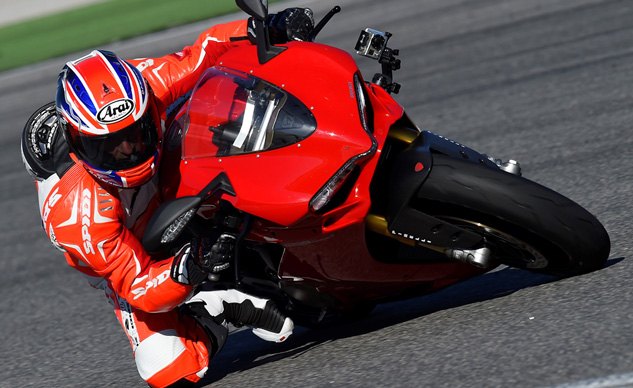

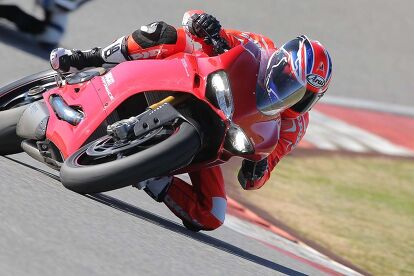













































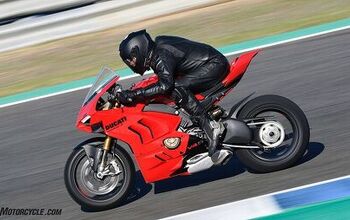




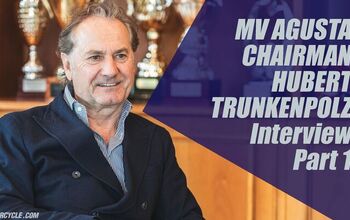


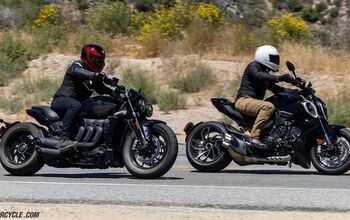







Comments
Join the conversation
Nice review and analysis. Looking forward to seeing the street review.
I truly need that power to unleash my potential as a rider, or to die trying. I always thought 100 hp was sufficient for whatever I wanted to do. Bought a Concours 14 last year, which isn't a sweet handler but is crazy fast in a straight line. Other than a Duc 996 still in the garage, this was the fastest bike I'd ridden. 205 hp must be ridiculous.